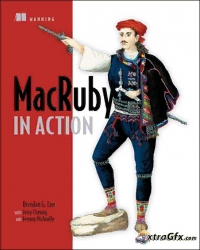Table Of ContentM A N N I N G
IN ACTION
Brendan G. Lim
Jerry Cheung
WITH
Jeremy McAnally
AND
www.it-ebooks.info
MacRuby in Action
www.it-ebooks.info
www.it-ebooks.info
MacRuby in Action
BRENDAN G. LIM
WITH JERRY CHEUNG
AND JEREMY MCANALLY
MANNING
SHELTER ISLAND
www.it-ebooks.info
For online information and ordering of this and other Manning books, please visit
www.manning.com. The publisher offers discounts on this book when ordered in quantity.
For more information, please contact
Special Sales Department
Manning Publications Co.
20 Baldwin Road
PO Box 261
Shelter Island, NY 11964
Email: orders@manning.com
©2012 by Manning Publications Co. All rights reserved.
No part of this publication may be reproduced, stored in a retrieval system, or transmitted, in
any form or by means electronic, mechanical, photocopying, or otherwise, without prior written
permission of the publisher.
Many of the designations used by manufacturers and sellers to distinguish their products are
claimed as trademarks. Where those designations appear in the book, and Manning
Publications was aware of a trademark claim, the designations have been printed in initial caps
or all caps.
Recognizing the importance of preserving what has been written, it is Manning’s policy to have
the books we publish printed on acid-free paper, and we exert our best efforts to that end.
Recognizing also our responsibility to conserve the resources of our planet, Manning books are
printed on paper that is at least 15 percent recycled and processed without elemental chlorine.
Development editor: Sara Onstine
Manning Publications Co. Technical proofreader: Nick Howard
20 Baldwin Road Copyeditors: Lianna Wlasiuk, Tiffany Taylor
PO Box 261 Proofreader: Melody Dolab
Shelter Island, NY 11964 Typesetter: Marija Tudor
Cover designer: Marija Tudor
ISBN: 9781935182498
Printed in the United States of America
1 2 3 4 5 6 7 8 9 10 – MAL – 18 17 16 15 14 13 12
www.it-ebooks.info
brief contents
PART 1 STARTING WITH MACRUBY ...........................................1
1 ■ Introducing MacRuby 3
2 ■ Using Macirb and the Apple development tools 37
3 ■ Going beyond the basics with Xcode Interface Builder 64
PART 2 TAKE IT FOR A SPIN ....................................................85
4 ■ Using the delegate pattern 87
5 ■ Notifications and implementing the observer pattern 104
6 ■ Using key-value coding and key-value observing 120
7 ■ Implementing persistence with Core Data 141
8 ■ Core Animation basics 168
PART 3 MACRUBY EXTRAS ....................................................187
9 ■ HotCocoa 189
10 ■ MacRuby testing 203
11 ■ MacRuby and the Mac App Store 216
v
www.it-ebooks.info
www.it-ebooks.info
contents
preface xiii
acknowledgments xiv
about this book xvi
about the authors xix
about the cover illustration xx
PART 1 STARTING WITH MACRUBY ...............................1
1 Introducing MacRuby 3
1.1 Introducing MacRuby 4
The MacRuby difference 4 ■ Setting up your environment 5
Hello World, part 1 6
1.2 Cocoa: What you need to know 7
Important classes and concepts 8 ■ How Cocoa implements
common design patterns 10
1.3 Objective-C and Ruby: what you need to know 11
A shared heritage 12 ■ Objective-C 101 13
Ruby 101 17
vii
www.it-ebooks.info
viii CONTENTS
1.4 Diving into MacRuby 21
Class structure 21 ■ Creating MacRuby classes 23
Syntax and method signatures 24 ■ Using Ruby and
Objective-C methods 26 ■ Creating user interfaces 27
1.5 Hello World, part 2 28
Creating an Xcode project 29 ■ Creating the interface 30
Creating the controller 32 ■ Connecting the interface and
controller 34
1.6 Summary 35
2 Using Macirb and the Apple development tools 37
2.1 Using external libraries with MacRuby 38
Loading frameworks 38 ■ Loading Objective-C libraries as
bundles 39 ■ Loading Ruby gems 41
2.2 Exploring Macirb 42
Comparing the Ruby and MacRuby consoles 42
Working in the MacRuby console 43 ■ Macirb tips
and tricks 43
2.3 Building a Pomodoro application in Xcode 47
Creating a new MacRuby project 47 ■ Constructing the
interface 50 ■ Creating the controller 53 ■ Connecting the
controller and the interface 56 ■ Running the application 58
Releasing the application 58
2.4 Summary 63
3 Going beyond the basics with Xcode Interface Builder 64
3.1 About Interface Builder 65
History of Interface Builder 65 ■ Getting around Interface
Builder 65
3.2 Creating connections 69
Understanding outlets 69 ■ Understanding actions 71
3.3 Creating the Todo List application 73
Constructing the user interface 73 ■ Creating the
model 79 ■ Creating the controller 79 ■ Connecting
outlets and actions 82 ■ Running and packaging the
application 83
3.4 Summary 84
www.it-ebooks.info
CONTENTS ix
PART 2 TAKE IT FOR A SPIN .........................................85
4 Using the delegate pattern 87
4.1 What are delegates? 88
How do delegate methods work? 88 ■ Implementing the delegate
pattern 89
4.2 Delegation as an extension technique 92
Delegation the Cocoa way 93 ■ Delegation using
Forwardable 93
4.3 Using delegation in a custom MacRuby web browser 94
Creating the browser interface 94 ■ Setting up the
controller 95 ■ Implementing delegate methods in the
controller 98 ■ Connecting outlets and actions 100
Taking MacRuby Browser for a spin 102
4.4 Summary 103
5 Notifications and implementing the observer pattern 104
5.1 Notifying multiple objects 105
When to use notifications 105 ■ Managing notifications 106
5.2 Setting up notifications 107
Creating notifications 108 ■ Posting notifications to the
notification center 108
5.3 Queuing notifications 109
Using posting styles 109 ■ Coalescing notifications 110
Queuing multiple notifications 112 ■ Removing
notifications 113
5.4 Responding to notifications 114
Adding notification observers 114 ■ Removing notification
observers 116
5.5 Building an iTunes-notification observer 116
Creating the script 116 ■ Running the script 118
5.6 Summary 118
6 Using key-value coding and key-value observing 120
6.1 Simplifying code with key-value coding 121
Accessing object properties with KVC 121 ■ Handling
unknown keys 123 ■ Understanding key paths and collection
operators 125
www.it-ebooks.info

